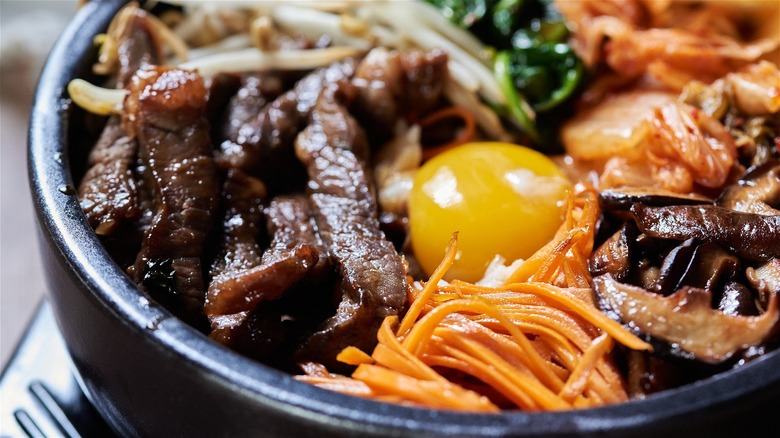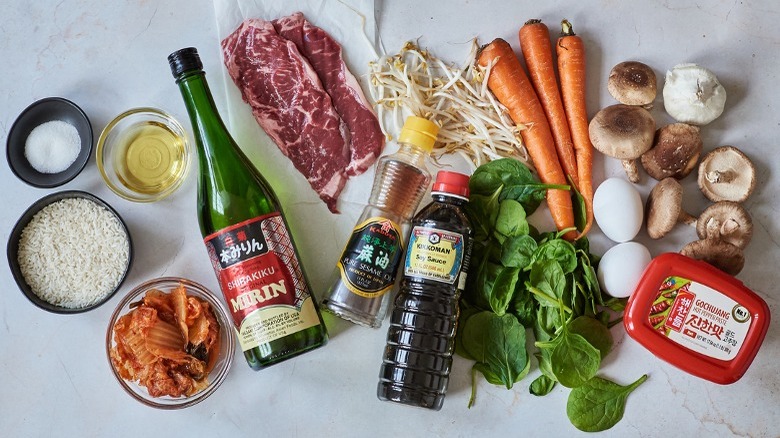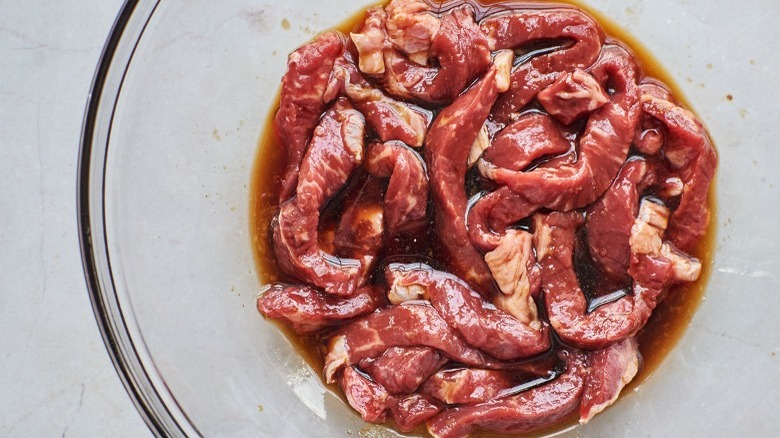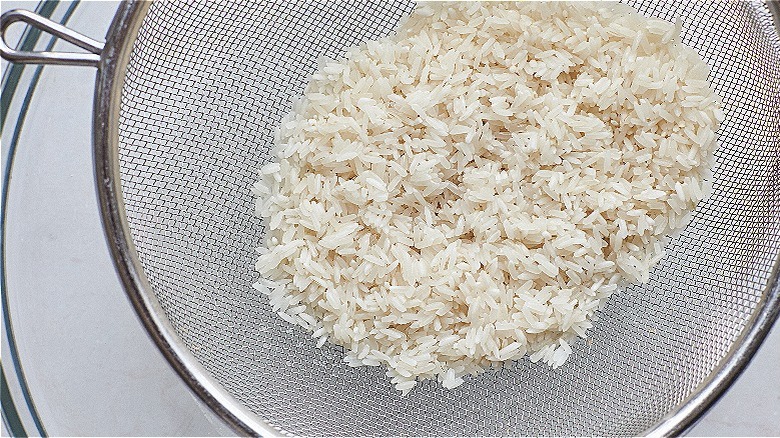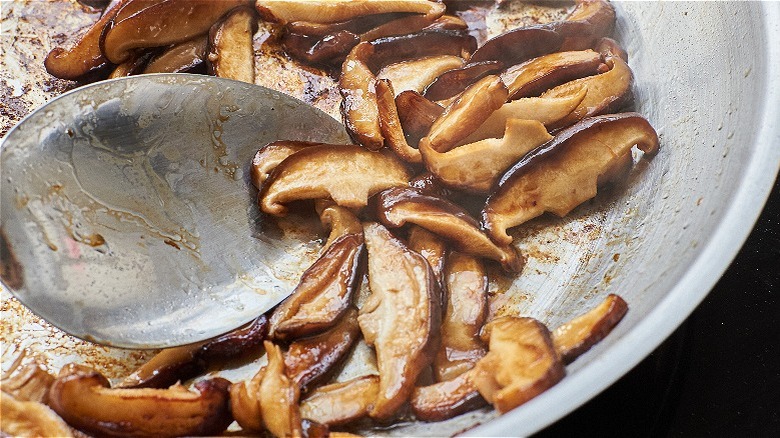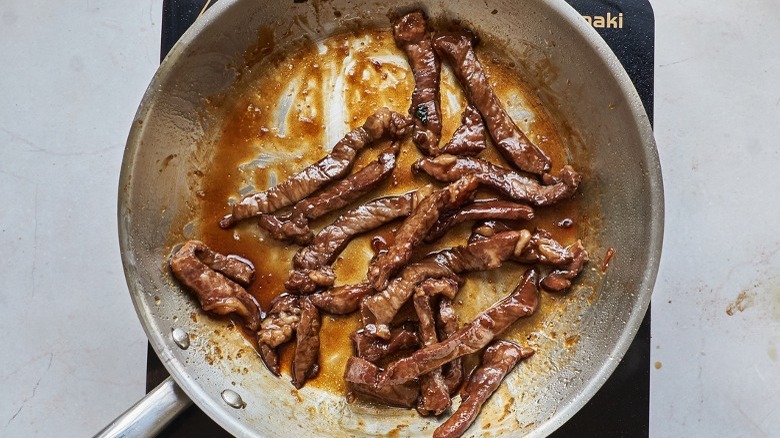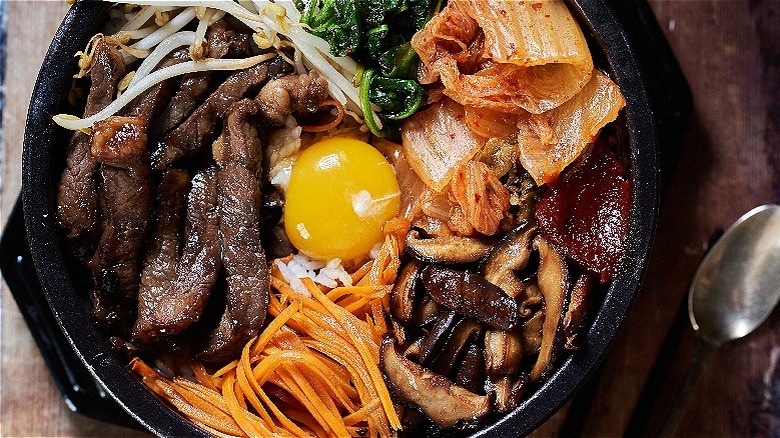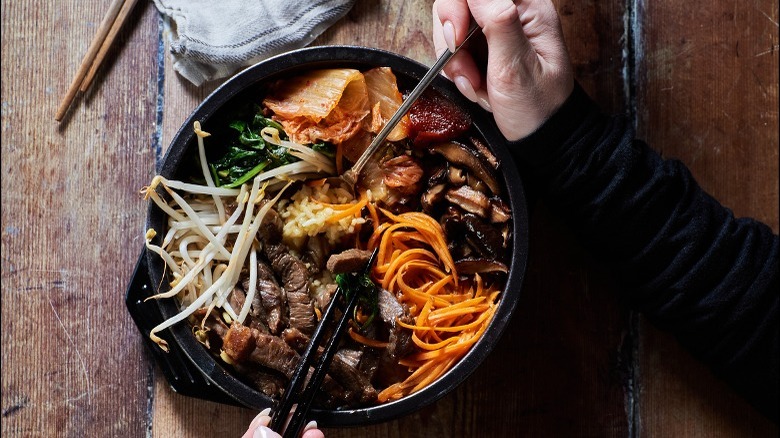Hot Stone Bibimbap Recipe
Bibimbap is a Korean dish made up of the words bibim, meaning "mixing," and bap, meaning "rice." The rice in bibimbap is mixed with marinated meat and fresh, sautéed, blanched, pickled, and/or fermented vegetables for a full meal with a lot of flavor. Not dissimilar from a grain bowl, bibimbap does differ from fried rice because the mix-ins are served on top of the rice rather than cooked along with it.
In hot stone bibimbap, cooked white rice is added to a dolsot, or a Korean-style heat-safe stone bowl, and then warmed until sizzling and hot. The rice gets crispy, the toppings get warmed, and the raw egg yolk dropped into the middle ever so slightly cooks in the heat of it all. If you don't have a dolsot, you can recreate this recipe by developer Michelle McGlinn to make regular bibimbap — but we highly recommend giving the hot stone method a try. Not only is the browned and crispy rice a pleasant change of texture, but the warm, runny egg coats the contents like a creamy, salty dressing. The best part? It's nutritious, easy, and can be made for lunch or dinner; even better if you have a few extra hands to help prep.
Everything you need for hot stone bibimbap
First, you'll need white rice, water, and sesame oil for the base of the bibimbap. You can use any white rice you prefer, but in this recipe we use long-grain white rice. You'll also need thin strips of beef for the protein — you can use pre-cut stir fry beef strips or buy a thin strip steak and slice it into strips yourself. The steak marinade contains soy sauce, mirin, sugar, and grated garlic, and if you don't have mirin, you can use sake or rice vinegar instead.
Feel free to get creative with the vegetables in this recipe; our favorites are shiitake mushrooms, carrots, spinach, and bean sprouts. Theses are joined by kimchi and gochujang, both of which can be found in Asian markets (though most supermarkets will likely have these near the soy sauce). To cook everything, you'll just need a little bit of neutral oil; olive oil will provide too strong a flavor, so opt for vegetable or canola. To finish the dish, you'll need at least one egg — one dolsot serves two people, so if you love the texture of a runny egg, grab an extra yolk.
Marinate the meat
While you can do this step up to 8 hours in advance, the meat only needs 20 to 30 minutes of marinating to develop a great savory flavor. However far ahead you're working, be sure to do this step first so you can prep the rice or chop the veggies while the beef soaks up the marinade. For the umami-rich mixture, whisk together soy sauce, mirin, sugar, and garlic, then briefly massage the marinade into the meat and set aside. If you're making the bibimbap all at once, you can leave the meat out at room temperature.
Prepare the rice
Because it takes the longest time to cook, you'll prepare the rice before starting on the veggies. Rinse the rice with a strainer until the water runs clear, then add to a saucepan. Add double the amount of water — for this recipe, that's 2 cups — and bring to a boil. As soon as the water begins to boil, turn the heat to low and cover. Steam the rice until the water is completely absorbed, about 15 to 20 minutes. If the water starts to boil over (this can happen with electric stovetops), crack the lid to let a little bit of steam escape. And if you have a rice cooker you totally adore? Feel free to use that here.
Cook the vegetable toppings
We recommend cooking the shiitake mushrooms first, so the spinach and carrots can absorb the flavors they leave behind in the skillet. Lightly oil the pan, then add the mushrooms and cook for a minute or two until they start to brown. Splash in the soy sauce and stir the mushrooms, cooking until they darken and soften. When the mushrooms start sticking to the skillet, remove them, leaving behind any browned bits and adding another splash of oil. Wilt the spinach in the pan and scrape the browned bits into the greens (you'll be surprised at how flavorful these are with the mushroom residue alone). Once the spinach is soft, remove and add the carrots, cooking until soft.
Brown the beef
At this point, the rice should be just about ready, so drop the marinated beef into a clean, hot, oiled skillet and toss until browned on all sides. Because it's steak, you don't have to cook it all the way through. Just focus on getting a lovely dark brown color on the outside, then remove it from the skillet.
Add everything to the hot stone bowl
If you don't have access to a proper dolsot, you can also make this bibimbap in a cast iron skillet, which will also crisp the rice but offer a different presentation. First, swirl the sesame oil around the bottom of the dolsot to lightly coat it, then add the rice. Place on the stovetop over medium heat. If your rice is particularly moist, getting it crispy will take a little bit longer. Heat until you hear a sizzling sound, then arrange the sautéed mushrooms, spinach, carrots, and beef in individual piles on top. Add the kimchi and bean sprouts to the bowl, then add a dollop of gochujang. After a few minutes, carefully remove the dolsot from the heat and place it on a trivet. Make a small nest in the middle of the bowl for the egg yolk — you can use the whole egg, if you prefer, but the flavor and texture comes from the yolk.
Serving hot stone bibimbap
Despite everything being served in one bowl, this amount of food is meant to serve two people. If you don't mind a more intimate dining experience, feel free to dig in, both of you sharing one bowl. For situations where sharing might not be feasible, first stir the yolk into the rice so the residual warmth cooks the egg. After mixing everything together, spoon single portions into smaller bowls. If you're not into raw eggs, you could instead cook the yolk in a separate skillet and add it on top of the bibimbap.
Bibimbap is a healthy meal that can be paired with a number of sides and drinks like cucumber salad, spicy radishes, and Korean alcoholic drinks like soju. It also saves well for meal prepping and is even better the second day, when the rice has dried out and can crisp even further in the dolsot. To reheat, simply add the contents back to the stone bowl until they sizzle, covering as needed to heat the toppings through. The gift that keeps on giving, it really doesn't get any better than bibimbap.
Hot Stone Bibimbap Recipe
This Korean recipe combines marinated beef, veggies, and kimchi over rice. Topped with an egg yolk, it's meant to be shared straight from the sizzling dolsot.
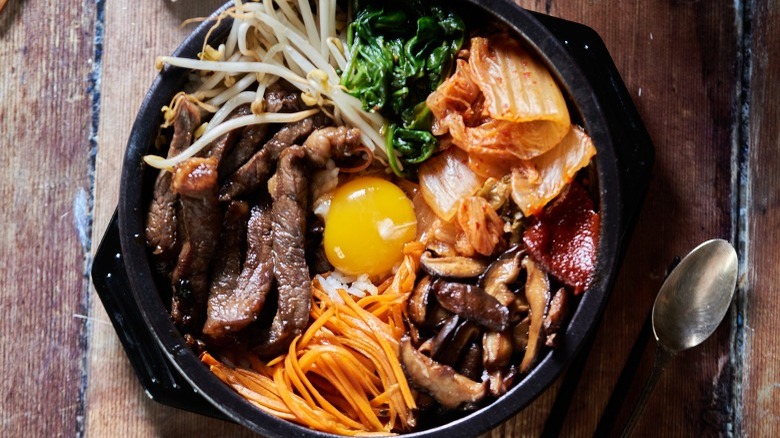
Ingredients
- ½ pound strip steak, thinly sliced
- 3 tablespoons soy sauce, divided
- 1 ½ tablespoons mirin
- 2 cloves garlic, grated
- 1 tablespoon granulated sugar
- 1 cup white rice
- 2 cups water
- ¼ cup neutral cooking oil, divided
- 5 ounces shiitake mushrooms, sliced
- 4 cups baby spinach
- 4 carrots, julienned
- 1 teaspoon sesame oil
- ½ cup bean sprouts
- ¼ cup kimchi
- 1 tablespoon gochujang
- 1 egg yolk
Directions
- Marinate the beef. Whisk together 2 tablespoons of soy sauce, mirin, garlic, and sugar, then add the beef and coat well. Set aside.
- Rinse the rice until water runs clear, then place in a saucepan with water. Bring to a boil, then lower heat to low and cover. Cook until water is completely absorbed and rice is fluffy, about 20 minutes.
- Heat a skillet or wok over medium heat and add a thin layer of oil. Add mushrooms and cook until starting to soften, then add remaining 1 tablespoon soy sauce. Cook until browned, soft, and glossy. Remove from the skillet.
- Add another layer of oil and add the spinach to the skillet. Stir into the oil until wilted and bright green, about 2 minutes. Remove from the skillet.
- Cook the julienned carrots until soft and glossy, about 2-3 minutes, adding oil as needed. Remove from the skillet.
- Add the steak and marinade to the skillet and cook until beef is deeply browned and marinade is reduced.
- To prepare the dolsot, swirl sesame oil around the bottom of the bowl. Add the rice, then place the dolsot over medium heat until you can hear the rice sizzling, about 5 minutes (or longer for crispier rice). Add the beef, mushrooms, spinach, carrots, bean sprouts, kimchi, and gochujang, each in their own pile. Make a nest in the middle of the toppings to reveal the rice, then drop the egg yolk into the nest.
- Serve immediately, stirring the egg yolk into the sizzling rice while the bowl is still hot.
Nutrition
| Calories per Serving | 1,067 |
| Total Fat | 52.7 g |
| Saturated Fat | 11.1 g |
| Trans Fat | 0.1 g |
| Cholesterol | 165.7 mg |
| Total Carbohydrates | 108.5 g |
| Dietary Fiber | 7.4 g |
| Total Sugars | 15.8 g |
| Sodium | 1,873.7 mg |
| Protein | 37.1 g |

